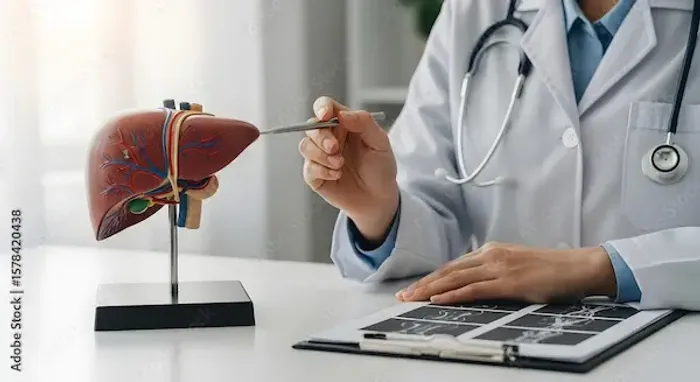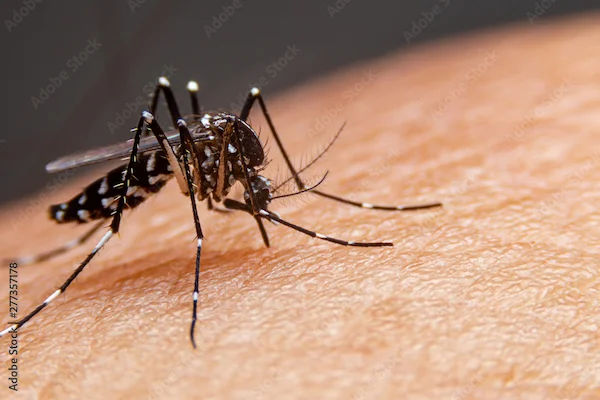Signs Of What Are The Common Signs And Of A Liver Disease
Discover the common early warning signs of liver disease, including fatigue, jaundice, digestive issues, and more. Learn when to seek medical advice for timely intervention.

Written by Dr. Siri Nallapu
Reviewed by Dr. Rohinipriyanka Pondugula MBBS
Last updated on 23rd Sep, 2025

Introduction: Your Liver's Vital Role and Why Its Health Matters
Your liver is the ultimate multitasker, a powerhouse organ performing over 500 essential functions. It filters toxins from your blood, produces bile for digestion, stores energy, and manufactures proteins crucial for blood clotting. Given its central role, early signs of liver disease can be subtle and easily mistaken for less serious conditions. Recognising these signals is critical for timely intervention. This article will guide you through the common signs and symptoms of liver disease, from the early, easily missed warnings to the more advanced physical manifestations. Understanding these signs empowers you to take proactive steps toward your health. If you experience any persistent symptoms, it's crucial to consult a healthcare professional for a proper evaluation.
Early Warning Signs of Liver Disease
The initial symptoms of liver disease are often vague and non-specific, meaning they can be attributed to a wide range of other illnesses. This is why they are frequently overlooked.
Persistent Fatigue and Weakness
One of the most common and debilitating early signs is an overwhelming and persistent sense of fatigue. This isn't just ordinary tiredness; it's a deep, unshakable exhaustion that isn't relieved by rest. The exact cause is complex but is linked to changes in brain chemistry and increased energy demands as the liver works harder to perform its functions.
Digestive Disturbances: Nausea and Loss of Appetite
A struggling liver can significantly impact your digestive system. You may experience a constant, unexplained nausea, a disinterest in food, or even a sudden aversion to foods you once enjoyed, particularly fatty foods. This happens because the liver's reduced ability to produce bile impedes the proper digestion of fats, leading to discomfort and a lack of appetite.
Abdominal Discomfort and Pain
Discomfort in the upper right quadrant of your abdomen, just below your rib cage, can be a direct sign of liver distress. This pain may feel like a dull ache, a throbbing sensation, or a sense of fullness. It is often caused by inflammation (hepatitis) or enlargement (hepatomegaly) of the liver, which stretches its sensitive covering membrane.
Consult a Hepatologist for the best advice
Visible Physical Signs of a Struggling Liver
As liver disease progresses, the symptoms often become more visible and physically apparent.
Jaundice: The Yellowing of Skin and Eyes
Jaundice is one of the most classic and recognisable signs of advanced liver dysfunction. It causes a yellow
discolouration of the skin, the whites of the eyes (sclera), and mucous membranes. This occurs when the damaged liver cannot efficiently process bilirubin, a yellow-orange bile pigment, causing it to build up in the bloodstream and tissues.
Skin Changes: Itching and Spider Angiomas
Liver disease can manifest on your skin in distinct ways:
- Pruritus (Itchy Skin): A persistent, widespread itchiness, often worse on the palms and soles, caused by bile salt deposits under the skin.
- Spider Angiomas: These are small, spider-like blood vessels visible just beneath the skin's surface, often on the face, neck, and chest. They are caused by elevated oestrogen levels, which a damaged liver cannot properly metabolize.
Swelling in the Legs and Abdomen (Oedema and Ascites)
A failing liver leads to low levels of albumin, a protein that helps keep fluid in the bloodstream. This fluid can leak into the tissues, causing swelling (oedema) in the legs and ankles. More seriously, fluid can accumulate in the abdominal cavity, a condition called ascites, which causes significant bloating and discomfort.
Changes in Waste Elimination
Your liver plays a key role in processing waste, so changes in urine and stool can be very telling.
Dark Urine and Pale Stools
These are two sides of the same coin. Dark urine (the colour of cola or tea) is caused by excess bilirubin being excreted by the kidneys. Conversely, pale, clay-coloured stools occur because bilirubin isn't reaching the intestines to give stool its normal brown colour. This combination is a strong indicator of a bile duct obstruction or severe liver impairment.
Bruising and Bleeding Easily
The liver produces clotting factors that help your blood to clot. When its function is compromised, you may bruise
much more easily from minor bumps or experience prolonged bleeding from small cuts. You might also notice frequent nosebleeds or bleeding gums.
Neurological and Cognitive Symptoms
In severe cases, the liver's inability to filter toxins can affect brain function.
Confusion and Brain Fog (Hepatic Encephalopathy)
This serious condition, known as hepatic encephalopathy, occurs when toxins like ammonia build up in the brain.
Symptoms can range from mild confusion, forgetfulness, and difficulty concentrating to more severe disorientation, personality changes, slurred speech, and even coma. This is a medical emergency.
When to See a Doctor: Don't Ignore These Signs
It is essential not to self-diagnose. If you experience one or more of these symptoms—especially if they are persistent, worsening, or occurring together—it is vital to seek medical advice. If symptoms like jaundice, abdominal swelling, or mental confusion appear, consult a doctor online with Apollo24|7 for further evaluation immediately. Early diagnosis is the key to managing liver disease effectively and preventing long-term damage.
Conclusion: Prioritising Your Liver Health
Your liver is a remarkably resilient organ, but it has its limits. Recognising the common signs of liver disease is the first step toward safeguarding your health. While this list may seem alarming, it is intended to educate and empower you to take action. Many forms of liver disease are manageable, and sometimes reversible, with early intervention. Lifestyle choices such as a balanced diet, limited alcohol consumption, and regular exercise contribute significantly to liver wellness. Listen to your body. If it's showing you these signs, prioritise a check-up. If your condition does not improve or you have ongoing concerns, book a physical visit to a doctor with Apollo24|7 for comprehensive testing and a personalised care plan.
Consult a Hepatologist for the best advice
Consult a Hepatologist for the best advice

Dr. Srinivasa Reddy
Hepatologist
12 Years • MBBS, MD (General Medicine), DM (Hepatology),ASGE
Hyderabad
Myra Liver & Gastro Care, Hyderabad

Dr. E Prabhakar Sastry
General Physician/ Internal Medicine Specialist
40 Years • MD(Internal Medicine)
Manikonda Jagir
Apollo Clinic, Manikonda, Manikonda Jagir
(150+ Patients)

Dr. Pukhraj Singh Jeji
Gastroenterology/gi Medicine Specialist
13 Years • MBBS, MD ( Internal Medicine ), DM ( Gastroenterology ), Consultant - Gastroenterology
Bhubaneswar
Apollo Hospitals Old Sainik School Road, Bhubaneswar

Dr. Kumaragurubaran. S
Hepatologist
0 Years • MBBS.,MD.,FPIC.,DM.,
Tiruchirappalli
Apollo Speciality Hospitals Old Palpannai, Tiruchirappalli
(25+ Patients)

Dr U V U Vamsidhar Reddy
Hepatologist
10 Years • MBBS, MD (JIPMER), DM (Hepatology, PGIMER)
Chennai
Apollo Hospitals Greams Road, Chennai
(75+ Patients)
Consult a Hepatologist for the best advice

Dr. Srinivasa Reddy
Hepatologist
12 Years • MBBS, MD (General Medicine), DM (Hepatology),ASGE
Hyderabad
Myra Liver & Gastro Care, Hyderabad

Dr. E Prabhakar Sastry
General Physician/ Internal Medicine Specialist
40 Years • MD(Internal Medicine)
Manikonda Jagir
Apollo Clinic, Manikonda, Manikonda Jagir
(150+ Patients)

Dr. Pukhraj Singh Jeji
Gastroenterology/gi Medicine Specialist
13 Years • MBBS, MD ( Internal Medicine ), DM ( Gastroenterology ), Consultant - Gastroenterology
Bhubaneswar
Apollo Hospitals Old Sainik School Road, Bhubaneswar

Dr. Kumaragurubaran. S
Hepatologist
0 Years • MBBS.,MD.,FPIC.,DM.,
Tiruchirappalli
Apollo Speciality Hospitals Old Palpannai, Tiruchirappalli
(25+ Patients)

Dr U V U Vamsidhar Reddy
Hepatologist
10 Years • MBBS, MD (JIPMER), DM (Hepatology, PGIMER)
Chennai
Apollo Hospitals Greams Road, Chennai
(75+ Patients)
More articles from General Medical Consultation
Frequently Asked Questions
1. Can you have liver disease without any obvious symptoms?
Yes, especially in the early stages. Liver disease is often called a 'silent' illness because significant damage can occur before any noticeable symptoms appear. This is why regular check-ups and blood tests are important, especially if you have risk factors.
2. What does liver disease skin rash look like?
It can vary. It may appear as general redness and itching (pruritus), or specific lesions like spider angiomas (small, spider-like blood vessels) or palmar erythema (reddening of the palms).
3. Is pain from liver disease constant?
Not always. Liver pain in the upper right abdomen can be a constant dull ache or it can come and go. It may be exacerbated by eating fatty foods or alcohol.
4. How quickly do signs of liver damage appear?
It depends entirely on the cause. Acute liver failure from, for example, acetaminophen overdose, can cause symptoms within days. Chronic damage from factors like alcohol or hepatitis C can take years or even decades to produce noticeable symptoms.
5. Can liver disease cause weight loss?
Yes, unintentional weight loss is a common symptom, particularly in later stages. This is often due to a combination of loss of appetite, nausea, and the body's impaired ability to process nutrients.




